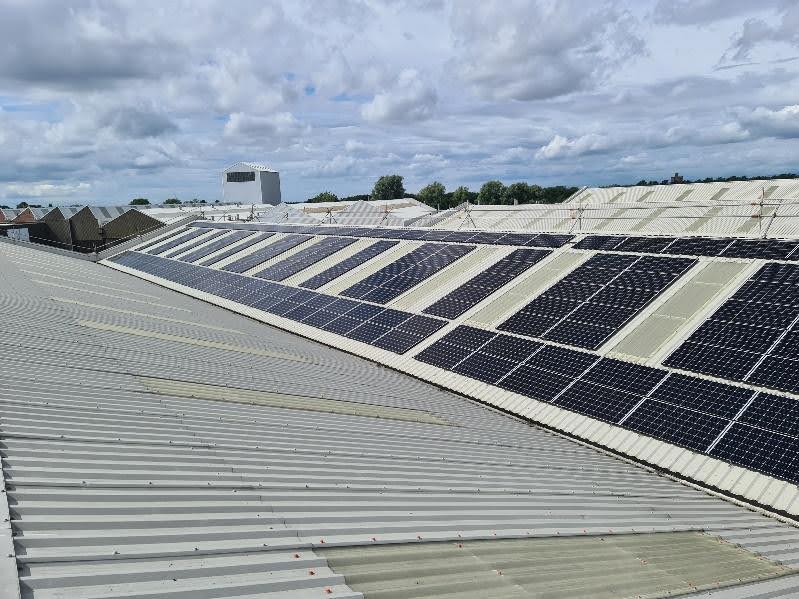As concerns over climate change intensify and the global community calls for reduced carbon emissions, businesses are increasingly expected to adopt sustainable practices.
For commercial landlords, this transition is not merely a regulatory requirement; it represents a strategic opportunity to enhance their properties’ value and attractiveness through environmentally friendly initiatives.
Among these, investing in solar energy systems emerges as a compelling option.
Such an investment not only demonstrates a commitment to sustainability but also offers a plethora of benefits to both landlords and tenants, making it a crucial step toward not only meeting but exceeding modern environmental standards.
The urgency for commercial landlords to embrace sustainable energy solutions is further amplified by the pressing need to contribute to the global fight against climate change.
By integrating solar power and other green technologies into their properties, landlords can significantly reduce their carbon footprint.
This not only aligns with the broader environmental goals but also positions their properties as leading examples of sustainability in action.
In turn, this commitment to green energy practices enhances the market appeal of their properties, attracting tenants who prioritise environmental responsibility while also navigating the evolving landscape of energy regulation.
Meeting Regulatory Standards: The Drive for a C Rating
In the realm of commercial real estate, achieving a C energy efficiency rating has become a pivotal target. This classification serves as a testament to a building’s energy efficiency and its minimal environmental impact.
Governments worldwide are tightening the noose on energy consumption standards, making a C rating an essential milestone for commercial landlords.
Attaining this rating by 2027 is not just about regulatory compliance; it’s about embodying a forward-thinking approach to property management, one that places a premium on sustainability and energy conservation.
The journey towards achieving a C rating is multifaceted, involving a comprehensive assessment of a property’s energy usage and environmental impact.
For landlords, this means adopting a series of strategic upgrades and investments, ranging from energy-efficient lighting and HVAC systems to the installation of solar panels.
Each step taken not only brings them closer to meeting these regulatory standards but also contributes to a larger vision of sustainable commercial property management.
Through these efforts, landlords can ensure their buildings are not just compliant but are also contributing positively to the environment, setting a standard for others in the industry to follow.
The Role of Solar Energy
Investing in solar energy stands at the forefront of sustainable strategies for commercial landlords aiming for a C rating.
Solar panels convert sunlight into electricity, providing a renewable energy source that can significantly reduce a building’s reliance on fossil fuels.
This shift not only aids in slashing carbon emissions but also plays a critical role in achieving energy efficiency benchmarks required for a C rating.
By harnessing the power of the sun, landlords can move towards a more sustainable operational model, one that benefits the environment, tenants, and their bottom line.
Beyond the environmental benefits, the financial implications of adopting solar energy are equally compelling.
Initial investments in solar technology may seem daunting; however, the long-term savings on energy costs and the potential for government incentives make it a financially viable strategy.
Furthermore, properties equipped with solar energy systems often see an increase in value, as demand grows for sustainable and energy-efficient commercial spaces.
This enhanced property value, coupled with operational cost savings, underscores the significance of solar energy investment as a key component in the quest for achieving and surpassing a C rating by 2027.
Green Features and Their Impact
Incorporating green features into commercial properties extends beyond solar energy systems, encompassing a broad spectrum of sustainable practices that collectively enhance a building’s environmental footprint.
Energy-efficient appliances and LED lighting systems serve as fundamental components of this green transformation, drastically reducing electricity consumption and operational costs.
These technologies not only contribute to achieving a C rating but also set a new standard for environmental responsibility within the commercial real estate sector.
Moreover, water conservation measures, such as low-flow toilets and smart irrigation systems, play a crucial role in sustainable property management.
By minimising water usage, landlords can significantly reduce utility expenses and demonstrate their commitment to preserving natural resources.
Similarly, enhancing a building’s insulation and optimising its envelope are critical steps toward improving energy efficiency and thermal comfort.
These improvements, along with the development of green spaces and biodiversity initiatives, not only contribute to a property’s sustainability profile but also improve the well-being and satisfaction of tenants.
Collectively, these green features create a compelling case for commercial landlords to invest in, offering a pathway to not only meet but exceed current regulatory standards and tenant expectations.
Benefits for Commercial Landlords
The decision to invest in solar energy and other green initiatives presents numerous benefits for commercial landlords, not least of which is the potential for significant cost savings.
By reducing reliance on traditional energy sources and lowering operational costs, landlords can achieve a more economically sustainable model of property management.
These savings, over time, can offset the initial investment required for green upgrades, leading to a strong return on investment that enhances the financial viability of sustainable practices.
In addition to economic benefits, sustainable properties often command higher rents and are more attractive to prospective tenants, increasing occupancy rates and ensuring a competitive edge in the market.
This increased marketability is especially relevant in an era where environmental consciousness is growing among businesses and consumers alike.
Properties that demonstrate a strong commitment to sustainability not only meet this demand but also contribute to a positive public image, reinforcing the landlord’s reputation as a leader in responsible property management.
Furthermore, the long-term return on investment, through enhanced property value and operational savings, underscores the strategic advantage of incorporating solar energy and green features into commercial real estate portfolios.
Conclusion
As the deadline for achieving a C energy efficiency rating approaches, commercial landlords are presented with a unique opportunity to lead the charge in sustainable real estate practices.
By investing in solar energy and implementing a range of green features, they can not only meet regulatory requirements but also position their properties as benchmarks of sustainability and innovation.
The benefits of such investments extend far beyond compliance, offering tangible financial returns, improved tenant satisfaction, and a significant contribution to the global effort against climate change.
In this rapidly evolving landscape, the commitment to sustainability emerges not just as a regulatory obligation but as a strategic asset, defining the future of commercial real estate.





